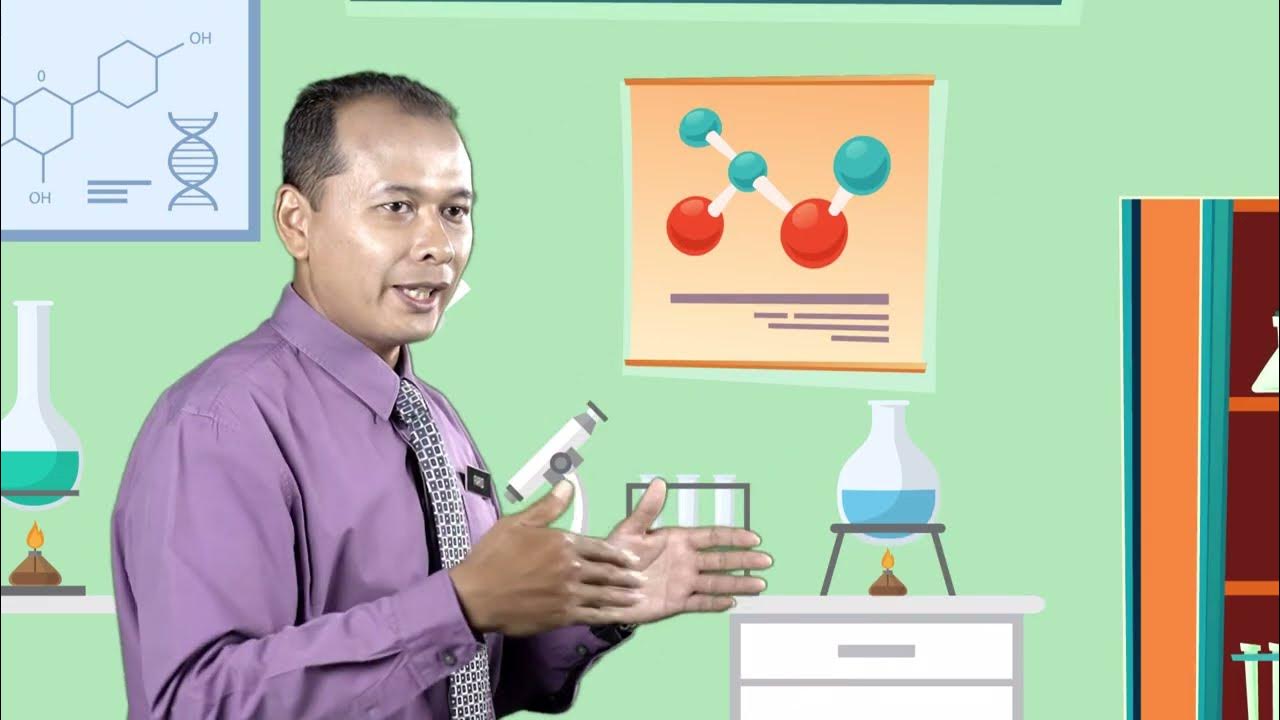JENIS PEMISAHAN CAMPURAN | Kimia kelas 10 | irma safitri
Summary
TLDRThis educational video by Irma Safitri covers methods of separating mixtures, essential in chemistry. It explains concepts like mixtures and the need to separate pure substances from them. The video introduces techniques such as filtration, evaporation, distillation, extraction, sublimation, and chromatography, each method based on physical properties like solubility and boiling points. It also touches on practical applications like salt production and testing food dyes, document inks, athlete's urine for banned substances, and pesticide levels in produce.
Takeaways
- 🔬 **Mixture Definition**: A mixture consists of two or more substances that retain the properties of their components.
- 🌐 **Purification Principle**: To obtain a pure substance, it must be separated from its mixture based on the differences in physical properties.
- 💧 **Filtration**: Used to separate insoluble solids from liquids by passing the mixture through a filter like filter paper.
- 🌡️ **Evaporation**: Separates dissolved solids from a solution by heating and allowing the solvent to evaporate, leaving the solid behind.
- 💧 **Distillation**: Separates mixtures based on different boiling points, where one component vaporizes first and then condenses back into a liquid.
- 🌿 **Extraction**: Separates a solute based on its differing solubility in two different solvents, often used to extract plant essences.
- 🧪 **Sublimation**: Separates a solid mixture based on the ability of one component to change state directly to gas without passing through a liquid phase.
- 🎨 **Chromatography**: Separates mixtures due to differences in solubility and adsorption on a medium like paper, used in various applications including food safety and doping tests.
- 🌱 **Practical Applications**: Chromatography is used to test the safety of food colorings, detect document fraud, screen for banned substances in athletes' urine, and check for pesticide residues in produce.
- 📈 **Separation Techniques**: Various methods like filtration, evaporation, distillation, extraction, sublimation, and chromatography are used to separate different components of a mixture.
Q & A
What is the main topic discussed in the video?
-The main topic discussed in the video is the separation of mixtures, specifically various methods to separate substances from mixtures based on their physical properties.
What is a mixture according to the video?
-A mixture is defined as a material composed of two or more substances, pure or more, and still retains the properties of the constituent substances.
Why is it necessary to separate substances from mixtures?
-It is necessary to separate substances from mixtures to obtain pure substances, as most materials found in nature are not pure but exist as mixtures.
What are the fundamental principles behind separating mixtures?
-The separation of mixtures is based on the differences in physical properties of the substances involved, such as state of matter, particle size, melting point, boiling point, magnetic properties, solubility, and others.
What is the first method of separation mentioned in the video?
-The first method of separation mentioned is filtration, which is used to separate a liquid from a solid that is not soluble.
How does the filtration method work?
-Filtration works by passing a liquid through a filter, such as filter paper, to separate insoluble solids. The solid particles are trapped by the filter, leaving a clearer filtrate.
What is evaporation and how does it separate mixtures?
-Evaporation is a method used to separate a solid dissolved in a liquid by heating the solution, allowing the water to evaporate slowly until it is gone, leaving behind crystals of the dissolved substance as residue.
Can you explain the distillation method as described in the video?
-Distillation is a method of separating mixtures based on the difference in boiling points. When a solution is heated, the component with the lower boiling point will vaporize first, then condense back into a liquid in a condenser or cooling device.
What is extraction and how does it separate mixtures?
-Extraction is a method of separating a mixture based on the difference in solubility of a substance in different solvents. It often involves using a solvent in which the desired substance is more soluble, allowing it to be separated from the mixture.
What is sublimation and how is it used to separate mixtures?
-Sublimation is a method of separating a solid mixture based on the substance's ability to change state directly from solid to gas or vice versa without passing through a liquid phase. It can separate substances that sublimate easily from those that do not.
What is chromatography and how does it help in separating mixtures?
-Chromatography is a method of separating mixtures based on the different solubilities of substances in a solvent and their different absorption or adsorption on paper. It is used in everyday life to test the safety of food coloring, detect counterfeit documents, screen for banned substances in athletes' urine, and check for pesticide residues in fruits and vegetables.
Outlines

Этот раздел доступен только подписчикам платных тарифов. Пожалуйста, перейдите на платный тариф для доступа.
Перейти на платный тарифMindmap

Этот раздел доступен только подписчикам платных тарифов. Пожалуйста, перейдите на платный тариф для доступа.
Перейти на платный тарифKeywords

Этот раздел доступен только подписчикам платных тарифов. Пожалуйста, перейдите на платный тариф для доступа.
Перейти на платный тарифHighlights

Этот раздел доступен только подписчикам платных тарифов. Пожалуйста, перейдите на платный тариф для доступа.
Перейти на платный тарифTranscripts

Этот раздел доступен только подписчикам платных тарифов. Пожалуйста, перейдите на платный тариф для доступа.
Перейти на платный тарифПосмотреть больше похожих видео

Form 1 | Science | DLP | Periodic Table | DLP0012

UNSUR, SENYAWA, DAN CAMPURAN - IPA KELAS 8 SMP KURIKULUM MERDEKA

Separação de Misturas: Tudo que você precisa saber! | Química | Quer Que Desenhe

Matter

The Different Types of Separation Techniques - Lesson 1 (Chemistry)

Kurikulum Merdeka Rangkuman Materi IPA Kelas 8 Bab 5 Unsur Senyawa dan Campuran
5.0 / 5 (0 votes)
